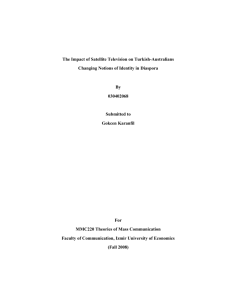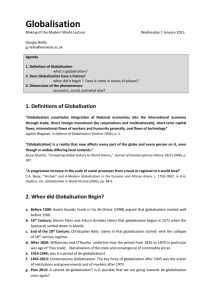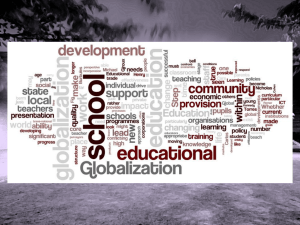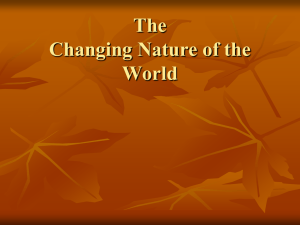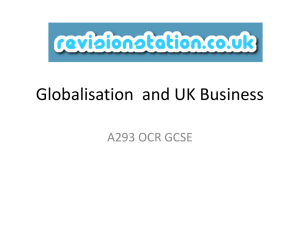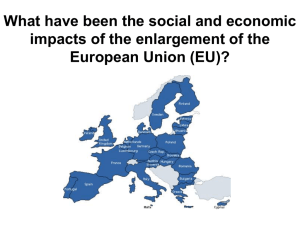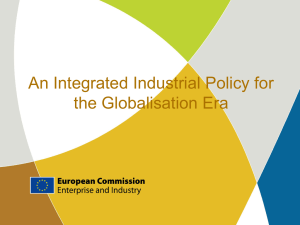Globalization: Definition, Dimensions, and Theories
advertisement
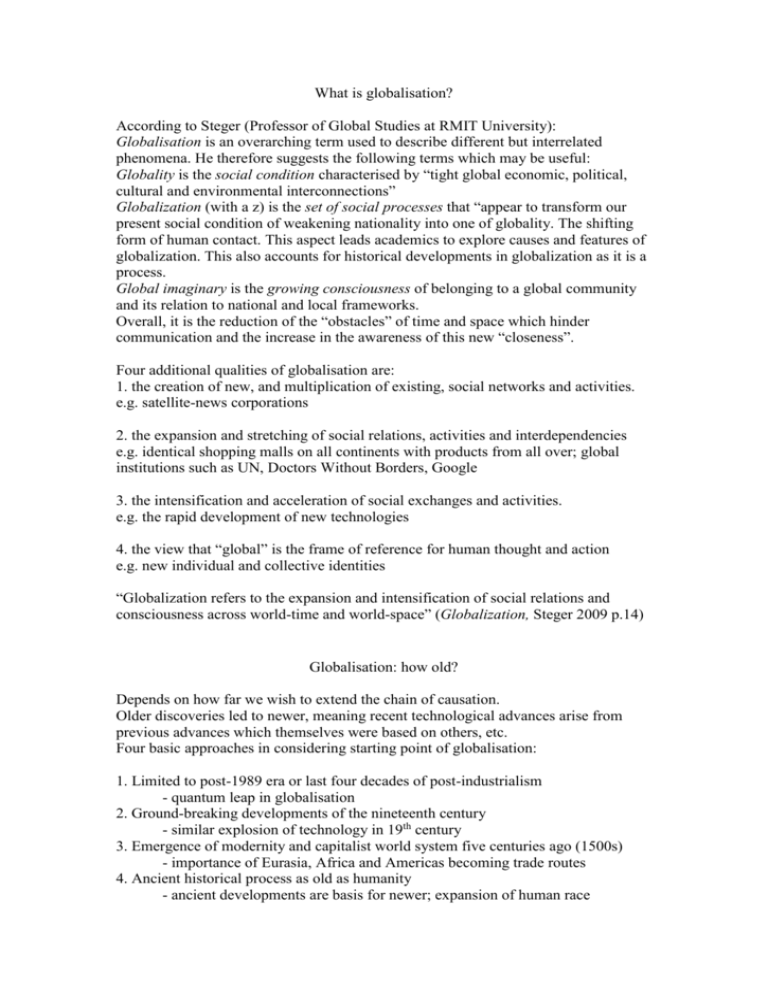
What is globalisation? According to Steger (Professor of Global Studies at RMIT University): Globalisation is an overarching term used to describe different but interrelated phenomena. He therefore suggests the following terms which may be useful: Globality is the social condition characterised by “tight global economic, political, cultural and environmental interconnections” Globalization (with a z) is the set of social processes that “appear to transform our present social condition of weakening nationality into one of globality. The shifting form of human contact. This aspect leads academics to explore causes and features of globalization. This also accounts for historical developments in globalization as it is a process. Global imaginary is the growing consciousness of belonging to a global community and its relation to national and local frameworks. Overall, it is the reduction of the “obstacles” of time and space which hinder communication and the increase in the awareness of this new “closeness”. Four additional qualities of globalisation are: 1. the creation of new, and multiplication of existing, social networks and activities. e.g. satellite-news corporations 2. the expansion and stretching of social relations, activities and interdependencies e.g. identical shopping malls on all continents with products from all over; global institutions such as UN, Doctors Without Borders, Google 3. the intensification and acceleration of social exchanges and activities. e.g. the rapid development of new technologies 4. the view that “global” is the frame of reference for human thought and action e.g. new individual and collective identities “Globalization refers to the expansion and intensification of social relations and consciousness across world-time and world-space” (Globalization, Steger 2009 p.14) Globalisation: how old? Depends on how far we wish to extend the chain of causation. Older discoveries led to newer, meaning recent technological advances arise from previous advances which themselves were based on others, etc. Four basic approaches in considering starting point of globalisation: 1. Limited to post-1989 era or last four decades of post-industrialism - quantum leap in globalisation 2. Ground-breaking developments of the nineteenth century - similar explosion of technology in 19th century 3. Emergence of modernity and capitalist world system five centuries ago (1500s) - importance of Eurasia, Africa and Americas becoming trade routes 4. Ancient historical process as old as humanity - ancient developments are basis for newer; expansion of human race Economic dimension of globalisation Global economic order Bretton Woods - - reversed protectionist interwar policies established binding rules on international economic activities resolved to create stable monetary system with currencies pegged to fixed gold value of US dollar set foundations for IMF, World Bank (at first called International Bank for Reconstruction and Development) and GATT, which became the WTO based on John Maynard Keynes’ economics (Keynesianism) This system worked until President Nixon took the dollar off the gold standard, leading to global economic instability in the 1970s Neoliberal policies then became popular. Neoliberalism - market is self-regulating; tends towards equilibrium of supply and demand any constraint on free competition would interfere with natural efficiency of market mechanisms advocates elimination of tariffs and barriers to trade and capital flows between nations based on liberal ideas of Adam Smith and David Ricardo introduction led by Reagan and Thatcher; rejection of Keynesianism movement legitimised by collapse of Soviet bloc Since this period, three features have been prominent: 1. the internationalisation of trade and finance 2. the power of transnationals 3. the enhanced role of economic institutions Political dimension of globalisation The nation-state system - dates from Peace of Westphalia in 1648 divided into sovereign states which recognise no superior authority states hold law-making decisions, etc. international law ruled by minimal rules of co-existance conflicts only between those involved all states equal before law differences settled by force collective priority is to reduce impediments to state freedom Development of intergovernmental organisations, which are designed to give expression to international cooperation but have led to political activities to take place across national boundaries, has led to the sovereignty of the nation-state to be undermined. Hyperglobalizers, i.e. those who emphasise the importance and effects of globalisation, see globalisation as causing the demise of the nation-state and as giving rise to a world in which internationally-linked regional economies determine a minimalist political order. Globalisation sceptics, on the other hand, say that political decisions are key in shaping the development of globalisation, saying that globalization has been significantly aided by the political decision to lift tariffs and protectionist policies. Cultural dimension of globalisation Cultural globalisation involves the construction, articulation and dissemination of meaning: in music, in language, and in image. Through technology exposure to different types of these is facilitated greatly. Does this lead to sameness or difference? “Pessimistic hyperglobalizers” suggest that because of globalisation, a homogenised popular culture based on Western culture is arising. e.g. Amazonian Indians wearing Nike trainers; people in Southern Sahara wearing Yankees baseball caps Sociologist George Ritzer coined the term “McDonaldization” to describe the expansion of principles behind American fast-food culture are spreading. Political theorist Benjamin Barber warns against the “ethos of infantilization” that sustains global capitalism – global consumerism is becoming soulless in the pursuit of profit. “Optimistic hyperglobalizers” say that increased sameness is a good thing. Francis Fukuyama welcomes this and thinks that the Americanisation of the world brings better lifestyles and values such as democracy and free markets. Some commentators, such as Roland Robertson, say that cultural globalisation means local cultures are invigorated – glocalisation, which involves cultural borrowing. Cultural globalisation has contributed to the expansion of people’s consciousness – global imaginary. Cultural globalisation may lead to hybridity. The role of the media: - led to the increase in the global imaginary - transnational corporations (TNCs) now dominate the media market smaller media outlets are dying out led to increased consumption of media depoliticization of social reality news has become more “entertainment” The globalisation of languages Researchers at Globalization Research Center at the University of Hawaii have identified 5 variables that influence globalisation of languages: 1. Number of languages – decline indicates increased homogenisation 2. Movements of people – languages are taken with them 3. Language tearning and tourism – spreads languages beyond national borders or cultural boundaries 4. Internet languages – as global medium for instant communication, language use on internet is a key factor 5. International scientific publications – contain languages of global intellectual discussion and so impacts knowledge around the world Globalisation of English is a historical development due to British colonialism. At the same time, number of languages spoken has dropped by over half. Ecological dimension of globalisation Global environmental issues have become more prominent in discussion since beginning of this century.

